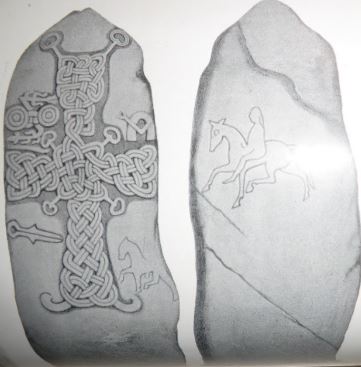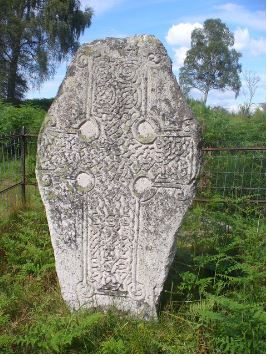Article 5 - St Nathallan, St Finan, St Adomnan
and the Loch Kinord Stone
Article 5 - St Nathallan, St Finan, St Adomnan
and the Loch Kinord Stone
Site of St Nathallan’s Church, Tullich Grid Ref NO 391975
Site of Migvie Cross, and Church (St Finan) Grid Ref NJ 437069
Site of Formaston Stone (St Adomnan) Grid Ref NO 529987
Site of Formaston Church (St Adomnan’s) Grid Ref NJ 541001
Site of Kinord Cross Grid Ref NO 439998
This article will deal with the above five sites which have much in common, but only four of them have a saint associated with it. It will also deal with the Pictish Stones associated with these sites, so I must first define the three classes of Stones I shall be referring to. These are:-
- Class 1 – Unworked stones with only pagan symbols incised. There is no cross on either side. Class I stones date back to the 6th, 7th, and 8th centuries.
- Class 2 – Stones of more or less rectangular shape with a large cross and pagan symbols on one or both sides. The symbols and Christian motifs are carved in relief and the cross with its surroundings is filled with designs. Class 2 stones date from the 8th and 9th centuries.
- Class 3 – These stones feature no idiomatic Pictish symbols, and are entirely Christian. The stones can be cross-slabs, recumbent gravemarkers, free-standing crosses, and composite stone shrines. They originate in the 8th or 9th century.
These three classes of stones extended over the period of evangelisation in Deeside, starting with the purely pagan symbols, then with Christian and pagan symbols on the same stone, and then to the period when the symbols were entirely Christian. It is a dramatic record covering some four centuries when the progress of Christianity is literally carved in stone. We are going to look at four sites, Tullich, Formaston (Aboyne), Migvie, and Loch Kinord to see what these sites tell us about this interesting and formative period.
Tullich is our starting point because it has the only Class 1 stone in our area associated with a church. The stone rested in the churchyard, but was recently moved by Historic Scotland to Edinburgh for conservation work, and will be returned to its site behind the railing at the church door. It bears the Pictish symbols of a double disc with Z-rod, an elephant, and a mirror without a comb. There are also fourteen other incised cross slabs also removed to Edinburgh. This site has strong connections with St Nathallan.

Formaston Aboyne has a Class 2 stone now situated in the Victory Hall, Aboyne. It is a fragment of a granite cross slab showing the lower part of the cross on the left and its interlaced work, and on the right hand side a mirror symbol, again without a comb. This stone has the added interest of Ogham writing on the right hand side, and the site has connections with St Adomnan who lived at the end of the seventh century. The mirror symbol on the surviving fragment will have been just one of several symbols on the original stone. We are fortunate that due to the efforts of our own Jane Kruuk this important stone is now exhibited in a safe environment where we can all see it in the foyer of the Victory Hall Aboyne. It will have stood about 6 feet high and the interlaced patterning is comparable with the stones at Migvie and Loch Kinord. Modern scholars ascribe the Ogham script to a later date, round about the ninth century.

At Migvie, there is another class 2 stone. It stands just inside the entrance to the kirkyard, with its front side facing east. It may be noted that the Migvie stone shares with Formston, Dyce and Monymusk the uncommon feature of representing symbols and crosses on the same face. It was discovered in the mid 19th century in the foundations of the old church and re-erected near the current entrance to the kirkyard. It stands 1.75m above the ground and is carved on both sides. On the east is a cross, the interior of which is infilled with interlacing, and the cross is flanked by a horseman and Pictish symbols, including a double disc and Z-rod, an arch and V-rod, and a pair of shears or tongs. On the reverse, is a horseman. Historic Scotland date this stone to the 8th or 9th century which would probably be a little later than the other class 2 Formaston stone, but we are probably looking at a continuity of culture in the Aboyne/Migvie area over the 7th to 9th centuries. The Migvie church was dedicated to St Finan.

Kinord. Here, near the edge of Loch Kinord, stands this magnificent Class 3 cross slab. This was originally said to have been situated near the ruined chapel at the Loch but was moved to the park at Aboyne Castle in the 19th century and restored to as near as possible to its original position in 1959 where it is now surrounded by a railed enclosure. It stands 6 ft high by 3 feet wide and is a fine example of a Celtic interlaced cross slab. It bears no Pictish symbols which probably dates it later than the other three stones mentioned above. No saint has been identified with the Loch Kinord site. Writing in Studies on the Book of Deer ( Four Courts 2008 Ed. Katherine Forsyth), Professor Thomas O Clancy sees a strong connection between these four sites in Mid Deeside. The Migvie and Formaston stones are the only two class 2 stones on Deeside. Migvie Formaston and Kinord all have crosses with plaited interlace designs on them and although lacking these features, Tullich has a large collection of incised cross slabs. All this leads Clancy to conclude that Migvie and Tullich were important ecclesiastical sites in the very early medieval period. The dedication to St Nathallan at Tullich gives it a 7th century start date, but the important crosses at Migvie and Formaston suggest continuity of culture and patronage into the 8th and 9th centuries.

I have given the above discourse on the four stone sites, hardly mentioning the saints that go with them but I must now do so.
St Nathallan, Tullich. The Aberdeen Breviary portrays Nathallan as a rich nobleman living in the 7th century, who decided to cultivate the earth in order to devote himself to God as a hermit. According to legend, Nathallan protested against God when a sudden storm interfered with his crop. When he realised what he had done, he was struck with remorse, and to punish himself, he locked his hand and leg together with a chain and iron lock and threw the key into the River Dee. He vowed that his arm would never be free until he made a pilgrimage to Rome. When he arrived in the holy city he met a boy who offered him a fish for sale. Nathallan bought the fish and recovered the key from its belly. When the Pope heard of this miracle, he decided to make Nathallan a bishop. This is a popular story and there are other similar stories involving our local saints. But what else do we know about St Nathallan? Modern scholarship links the name Nathallan with Nechtan, a common Pictish name and Professor Clancy links the dedication to Nathallan/Nechtan at Tullich to similar dedications at Abersnithock (near Monymusk,) Bethelnie, and Cowie just north of Stonehaven. Suddenly we are looking at a much larger area than Upper Deeside where Nathallan/Nechtan’s cult exerted its influence, but Clancy sees this as consistent with the possible connection of Nathallan/Nechtan with the very early Abbey at Deer, and also the one at Monymusk. It is also consistent with the traditional date of death of Nathallan/Nechtan in 678 AD.
St Adomnan, to whom the church at Formaston (Aboyne) was dedicated lived from 627/8 to 704 and in addition to being a relative of St Columba, was also his biographer, which is his main claim to fame. In 679, he became the ninth Abbot of Iona after Columba and being a contemporary of Nathallan, will have known him well. However there is no record of Adomnan ever coming to Formaston and the date of the dedication of the church there to him is also uncertain. There was certainly a Pictish settlement at this site and probably a pre-Pictish one. In the right light the cultivation strips can be seen on the fairway of the nearby golf course.

St Finan, Migvie. Assessing St Finan’s place in this culture is equally difficult. He is listed as the second bishop of Lindisfarne who died on 9th February 661. Much of his missionary work took place in Northumbria, and the Aberdeen Breviary styles him “a man of venerable life, a bishop of great sanctity, and an eloquent teacher of unbelieving races—“. We have no evidence that he ever came to Migvie, but there is evidence of a cult of St Finan in Talathrowie near Gartly where a well and probably a chapel were dedicated to him, and at Abersnithack near Monymusk where a chapel was dedicated to him. The dedication of the church at Migvie is recorded in a 12th century conveyance by Agnes , Countess of Mar to St Andrews of the “ecclesia S. Finani de Miggeveth”. The association of Lumphanan with a saint Finan rests purely on the name which is derived from the Gaelic word for church lann combined with the saint’s name. So behind the stone there is the shadowy presence of St Finan in Deeside and Donside with no evidence of his ever being there nor is any reason known for these dedications.
Loch Kinord. No saint is associated with this cross but in a sense, it represents the triumph of the earlier saints because no pagan symbols are present on either side of it. It is unequivocally a Christian symbol carved at or soon after the creation of a unified Scotland under Kenneth MacAlpine in the late 9th century. Confidence was filling the new united nation of Alba, a confidence that is surely reflected in the perfect proportions of the cross itself.
© Hugh Cochran 2012
Discover more….
